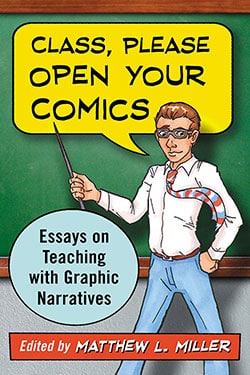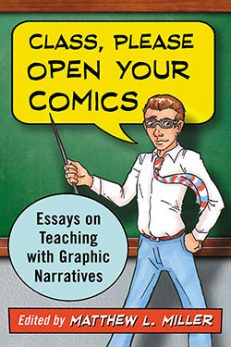Class, Please Open Your Comics
Essays on Teaching with Graphic Narratives
$29.95
In stock
About the Book
Comics and sequential art are increasingly in use in college classrooms. Multimodal, multimedia and often collaborative, the graphic narrative format has entered all kinds of subject areas and its potential as a teaching tool is still being realized.
This collection of new essays presents best practices for using comics in various educational settings, beginning with the basics.
Contributors explain the need for teachers to embrace graphic novels. Multimodal composition is demonstrated by the use of comics. Strategies are offered for teachers who have struggled with weak visual literacy skills among students.
Student-generated comics are discussed with several examples. The teaching of postmodern theories and practices through comics is covered. An appendix features assignment sheets so teachers can jump right in with proven exercises.
About the Author(s)
Bibliographic Details
Edited by Matthew L. Miller
Format: softcover (6 x 9)
Pages: 284
Bibliographic Info: 13 photos, notes, bibliography, appendix, index
Copyright Date: 2015
pISBN: 978-0-7864-9514-6
eISBN: 978-1-4766-1917-0
Imprint: McFarland
Table of Contents
Table of Contents
Acknowledgments xi
Introduction—Graphic Novel Pedagogy: Starting to Learn Together (Matthew L. Miller) 1
Section I. Getting Started: Advice for Beginners
Working on Understanding Comics: Introducing the Teacher to the Graphic Novel (Cecile de Rocher) 21
Comics as Literature, Comics as Culture: Teaching Graphic Fiction in the Undergraduate Classroom (Michael Buso) 30
Comics Make Great Prompts: Using Graphic Novels to Teach Writing in College Classrooms (Karen W. Gavigan) 40
Section II. Encountering Challenges: Graphic Novels in Various Settings
“Outside the Box”: Teaching Graphic Narrative in the Multicultural Community College (David Bahr) 51
Graphic Interventions: Introducing the Graphic Novel into the Classroom in a Small, Rural College Setting (Travis W. Johnson and Jeremy Reed) 62
(Religious) Fun Homes: Teaching the Lesbian Feminist Graphic Novel in a Catholic University (Scott A. Dimovitz) 79
Section III. Writing for Multimodality: Graphic Novels in Contemporary Composition
Multimodality 101: Graphic Narratives and Multimodal Composition (Andrew Bourelle) 91
Talismans: Using Comics to Teach Multimodal Writing (Aaron Kashtan) 103
More than Storyboards: Maintaining a Space for Graphic Novels in the Face of Film Adaptation (Jason Salinas) 117
Section IV. Reaching Beyond Limits: Complex Teaching Methods
Teaching Alison Bechdel’s Fun Home: The Construction of a Modernist Lesbian Graphic Novel (Julia Klimek) 131
Coming to Terms with the Past: Teaching German History with the Graphic Novel (Elizabeth Nijdam) 143
Defending the Graphic Novel: An Introduction to Literary Theory (Michael Demson) 155
Section V. Self-Reflexivity, Intertextuality and Other Scary Terms:
Postmodernism in Graphic Novels
Old Father, New Artificer: Teaching Alison Bechdel’s Fun Home as Postmodern Literature (Jeffrey Roessner and Eithne Amos) 169
Author/Character: Persepolis as a Gateway to Reading Metafictional Novels (Rhonda Knight) 181
Intertextual Journeys: Black Culture, Speculative Fiction and the Past as Text in Jeremy Love’s Bayou (Qiana Whitted) 195
Section VI. Looking Ahead: Graphic Novel Education for the Future
Doing Justice to the Graphic Novel: Comics as Curriculum in Young Adult Literature (Amanda M. Greenwell) 217
A Mission: Why Should 21st Century Secondary Language Arts Educators Teach Reading and Writing with Graphic Novels? (Katie Monnin) 231
Appendix: Best Practices Assignments 249
History Assignment (Karen W. Gavigan) 249
Panel-to-Panel Drawing Exercise (David Bahr) 250
(Auto)Biographical Short Story (Scott A. Dimovitz) 251
Memoir Assignment (Andrew Bourelle) 251
Comics Analysis (Aaron Kashtan) 254
Composing a Graphic Novel (Jason Salinas) 256
Podcast Assignment (Michael Demson) 257
Theoretical Application (Matthew L. Miller) 258
Exploring Adaptation in Historical Comics (Qiana Whitted) 258
Creative Assignment (Qiana Whitted) 260
Prompts for Close-Reading Graphic Narratives (Amanda M. Greenwell) 260
Teaching the Key Elements of Story (Katie Monnin) 262
About the Contributors 265
Index 269
Book Reviews & Awards
“will be useful for teachers who would like to include graphic narratives in a course but are uncertain how to do it or those who are interested in using these texts more effectively in their classes…recommended”—Choice.





